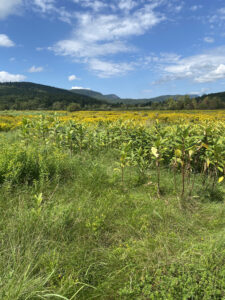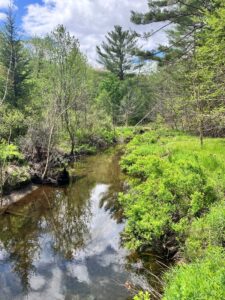(by Dyanna Smith)
New Hampshire Audubon is pleased to announce the establishment of Ines and Fredrick Yeatts Wildlife Sanctuary in Warren, NH. The Yeatts’ gift to NH Audubon of the 545-acre property creates NH Audubon’s 40th wildlife sanctuary. The new sanctuary abuts the White Mountain National Forest along the west and north borders.

The land is rich in wildlife with signs of bear, moose, porcupine, beaver, mink, and many species of forested upland and grassland birds. Habitat on the sanctuary includes oak-pine forests, important wetland complexes, and grassland fields. It becomes the sixth-largest sanctuary under the protection and management of NH Audubon.
NH Audubon’s State of the Birds report (2020) says that 16 of the 21 bird species needing grassland habitat are in decline, including Bobolink and Eastern Meadowlark. The most important strategies to ensure these birds thrive are to identify and protect high quality grasslands, and manage them appropriately. “If we want to get serious about protecting these birds, we have to commit to protecting their habitat and working with partners to do the same,” said NH Audubon President, Doug Bechtel.
The donors, Ines and Fred Yeatts, said, “we hope this land will help save species of wildlife and offer the enjoyment of nature to the sanctuary’s visitors.” United by their shared passion for the outdoors and wildlife, Ines and Fred Yeatts were inspired to create a biologically diverse wildlife sanctuary.

Ines and Fred both grew up in mountainous regions and share a common love of the natural world. After meeting in Colorado’s Front Range, Ines and Fred traveled in the Blue Ridge, White Mountains, and the Swiss Alps. With nature and wildlife as the foundation of their lives, their vision for this property becomes a lasting legacy that allows others to enjoy and appreciate the mountains and wildlife they both cherish.

“It has been awe-inspiring to work with Ines and Fred,” says NH Audubon’s Land Manager, T. Parker Schuerman. “Their conservation ethic and their vision to assemble a mosaic of different habitats that support a broad range of wildlife is completely inspirational.”
Plans for the new sanctuary include developing a small parking area, posting an informational kiosk, and designating access trails for walking within the property – all coming in the next year and a half.
“We are so pleased to protect this incredible landscape as our 40th Wildlife Sanctuary,” explains Bechtel. “Ines and Fred Yeatts have been extraordinary in their generosity to help ensure these wildlife habitats persist under our care.”
